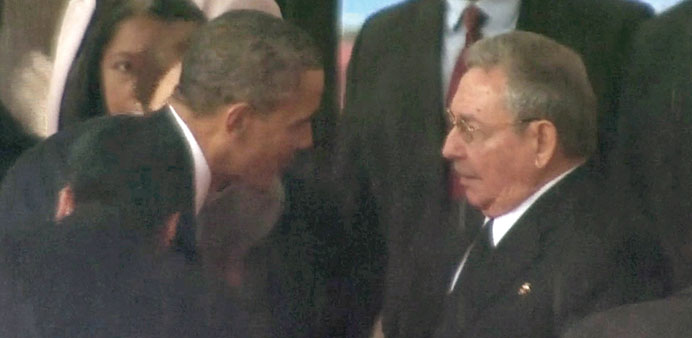AFP/Havana
Beyond this week’s handshake between the presidents of the United States and Cuba, a slow thaw in bilateral ties has helped foster reconciliation among Cubans on both sides of the Florida Straits.
The rare encounter between Barack Obama and Raul Castro during a memorial in South Africa for anti-apartheid hero Nelson Mandela came as the two countries work towards revamping their longstanding frosty relationship, a US diplomat in Havana told AFP.
“It’s all about avoiding unnecessary confrontations,” the diplomat added on condition of anonymity, emphasising that exchanges between the two countries have increased over the past several months.
The improved relations have had a tangible impact both for the 1.5mn people of Cuban descent who live in the United States and for the 11mn people living on the Caribbean island.
For one thing, the Obama administration’s relaxed rules about US travel to the Americas’ only Communist country have helped 500,000 Cuban Americans visit this year.
Remittances sent home by the Cuban diaspora – 80% of whom live in the United States – have also reached record levels: some $2.5bn a year, the second biggest source of foreign currency on the island.
And, with the ideological animosity of the 1960s and 1970s fading, the process of national reconciliation has expanded beyond family ties.
In January, Cuban authorities began allowing citizens to travel abroad without an exit visa, as had been required for 50 years.
That has allowed artists, athletes and students to travel more often, and let those branded “traitors” or “deserters” by the regime of long-time leader Fidel Castro return to Cuba.
Musicians that had been “forbidden” – including Isaac Delgado, Tanya Rodriguez and Manolin, known as the “Salsa Doctor” – as well as actress Lili Renteria have also recently come back to Cuba after long years away.
And, in a powerful symbol of the about-face, state-run newspaper Granma recently paid homage to artists who have been exiled for decades and were all but forgotten back home.
The root of the changes can perhaps be traced to the fall of the Soviet Union in the 1990s, when Cuba’s communist regime lost its most powerful backer.
In the years since, the government has become “less ideological but more nationalistic”, explained sociologist Nelson Valdes, a professor emeritus at the University of New Mexico.
In parallel, the Cuban diaspora has shifted from people who fled for political and ideological reasons to those who left for economic ones.
These new emigrants have a different attitude toward the country they left behind, explained University of Denver professor Arturo Lopez-Levy.
“Young Cubans living abroad want to preserve their contacts with Cuba, in contrast to their parents,” he said.
Cuba’s Catholic Church, which in the absence of legal political opposition has become the regime’s favoured interlocutor, has also become an active promoter of the ongoing reconciliation, organising debates, forums and reviews.
“Dialogue between the diverse groups that compose our society is the only way to achieve the social transformation underway in Cuba,” the Cuban church leadership said in September.
Lopez-Levy added: “Reconciliation today is a necessity for development and for the stability of the country.”
“But it should clearly be done in line with national interests, values and balanced with internal power,” he said.

Obama shakes hands with Castro in this still image taken from video courtesy of the South Africa Broadcasting Corporation.
